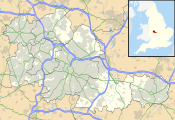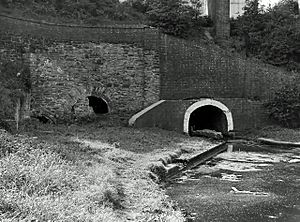Dudley Tunnel facts for kids
 |
|
| Overview | |
|---|---|
| Location | Dudley, West Midlands, England |
| Coordinates | 52°31′03″N 2°05′12″W / 52.517544°N 2.086741°W |
| OS grid reference | SO942910 |
| Status | Part-open |
| Waterway | Dudley Canal No 1 Line |
| Start | 52°31′18″N 2°04′42″W / 52.52173°N 2.07840°W |
| End | 52°30′04″N 2°06′03″W / 52.50110°N 2.10086°W |
| Operation | |
| Owner | Canal & River Trust |
| Technical | |
| Construction | 1775 - 1791 |
| Length | 3,172 yards (2,900.5 m) |
| Towpath | No |
| Boat-passable | No |
The Dudley Tunnel is a long canal tunnel located in Dudley, England. It is part of the Dudley Canal Line No 1. At about 3,172 yards (2,900 meters) long, it is one of the longest canal tunnels in the UK. However, it's not one continuous tunnel. It is made up of a main tunnel, Lord Ward's tunnel, and a basin called Castle Mill.
In 1959, the tunnel was almost closed for good. But people who loved canals protested to keep it open. Even though there were protests, the tunnel closed in 1962. There were even plans to block the tunnel entrance with a railway embankment. Luckily, this never happened. The railway line closed in 1968, and the old bridge was taken down later.
Thanks to local volunteers and the Dudley Council, the tunnel was reopened in 1973. This was a big event called "TRAD 1973 - Tunnel Reopening at Dudley." Today, it's a popular spot for boat trips and exploring history.
Contents
Why was Dudley Tunnel built?
The Dudley Tunnel system was first built to help transport limestone. This limestone was dug out from mines inside Castle Hill. The tunnel runs right through this hill.
In 1775, a local landowner, Lord Dudley and Ward, started building a private canal. This canal connected to the Birmingham Canal at Tipton. It went through a tunnel to reach his mines. This part was called Lord Dudley and Ward's branch.
Later, the Dudley Canal Company wanted to connect their canal to the Birmingham Canal. This meant building a very long tunnel. Lord Dudley and Ward agreed to sell his private canal and tunnel to the company. This new, longer tunnel was approved in 1785.
Building the main tunnel
Building the main tunnel was a huge challenge. The company wanted the tunnel to be 9 feet 3 inches (2.8 meters) wide. The water inside would be 5 feet 6 inches (1.7 meters) deep. There would be 7 feet (2.1 meters) of headroom for boats.
The first builder, John Pinkerton, faced many problems. He struggled with the ground and lots of underground water. He was eventually fired in 1787. After some delays, other engineers took over. The tunnel was finally finished on June 25, 1791.
How the tunnel was used
The tunnel was very busy, especially with boats carrying limestone from the quarries. Sometimes, it was hard for other boats to pass through. The tunnel also had problems with the ground sinking because of nearby mining. This meant it often had to close for repairs.
Boats could only go in one direction at a time. They would allow boats to pass for a few hours, then switch directions. In 1830, the time allowed was shortened to three hours. If a boat took too long, there was a penalty!
Even with these challenges, the tunnels were popular with people who wanted to see them. Many poems and descriptions were written about the tunnel.
Joining a bigger network
After building the Dudley Tunnel, the company kept expanding. They built another extension to connect to the Worcester and Birmingham Canal. This new part was finished in 1798. The original canal and tunnel then became known as the Dudley Canal Line No 1.
In 1846, the Dudley Canal joined with the Birmingham Canal Navigations. This made the Dudley Tunnel part of a much larger canal system.
By 1853, about 41,000 boats passed through the tunnel each year! To handle all this traffic, a new, wider tunnel was built. This was the Netherton Tunnel, which opened in 1858. It was much bigger and even had gas lights inside.
In 1884, part of the Dudley Tunnel had to be rebuilt because of ground sinking. About 200 yards (183 meters) were made much wider than the original tunnel. You can still see where the tunnel suddenly gets narrower today.
Why Dudley Tunnel closed and reopened
By 1959, hardly any boats used the Dudley Tunnel. The company that owned it, British Waterways, planned to close it. Many groups protested in 1960, hoping to keep it open. But British Waterways wanted to close many canals. The Dudley Canal and Tunnel officially closed in 1962.
The next year, a railway bridge near the tunnel entrance was found to be unsafe. The railway wanted to replace it with a solid bank of earth, which would have blocked the tunnel forever. However, the railway line closed completely in 1968. So, the tunnel entrance stayed open.
Bringing the tunnel back to life
Even though it was closed, some people still explored the tunnel. Vic Smallshire and his friends went through it and found a message in a bottle. This led to plans to save the tunnel. They started making regular trips through the tunnels. If barriers were put up, they would remove them!
A group called the Dudley Tunnel Committee was formed. They worked to get the local community interested in saving the tunnel. In 1964, the Dudley Canal Tunnel Preservation Society was officially created. This group grew quickly and had hundreds of members.
The Society also started talking to Dudley Council about creating an industrial museum. The idea was very popular. The Society later became the Dudley Canal Trust. They expanded their plans to include the locks and basins near the tunnel.
In the late 1960s, attitudes towards canals changed. The government started supporting their use for fun and recreation. The Dudley Canal Trust began working to restore the tunnel in 1970. They borrowed equipment from the council and local companies. Their hard work led to the tunnel reopening in 1973.
Exploring Dudley Tunnel today
The Dudley Tunnel is quite narrow, and it doesn't have a towpath (a path for horses to pull boats). This means many boats cannot go through it. Also, boats with diesel engines are not allowed because there isn't enough fresh air inside.
Visitors can take a special boat trip through the tunnel. These boats are powered by batteries so they don't produce fumes. On these trips, you can learn about the tunnel's history and even try "legging" the boat. Legging is an old way of moving boats through tunnels by pushing off the walls or ceiling with your feet!
The rock in Castle Hill, where the tunnel is dug, is made of limestone. This rock is special because you can see trilobite fossils in it! These are ancient sea creatures. Some important fossils near the water have been removed to protect them. Other parts of the tunnel go through different types of rock, like "Rowley Rag" and "Coal Measures" rocks.



